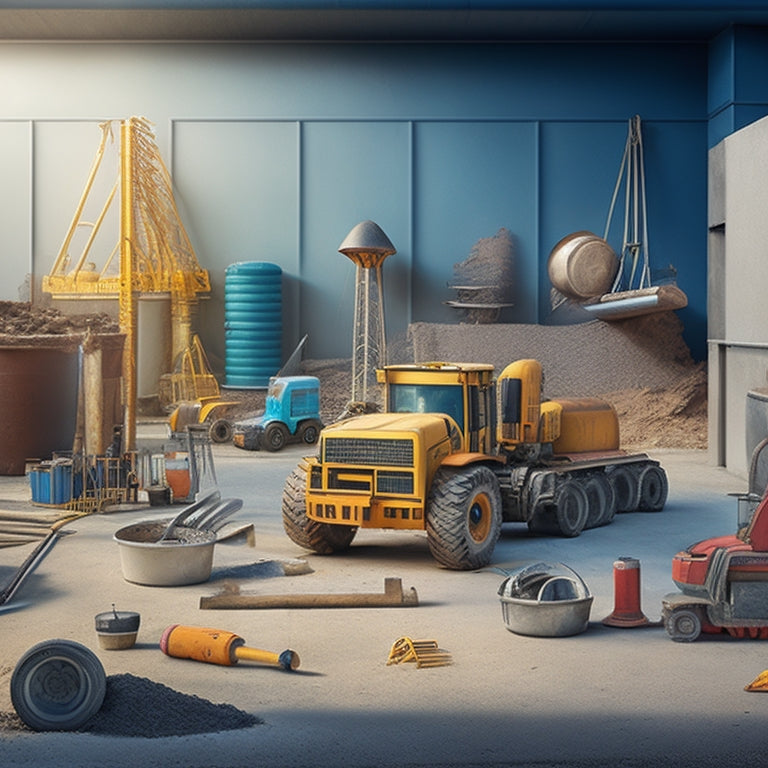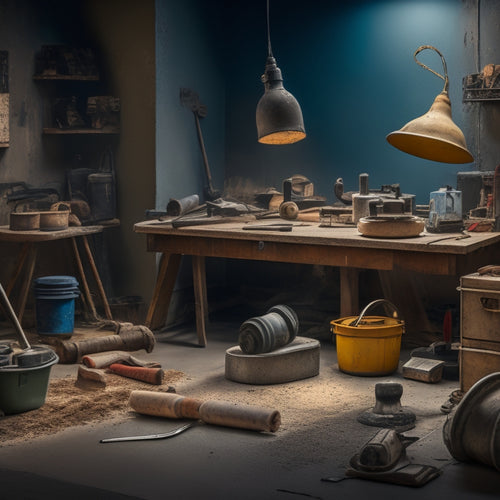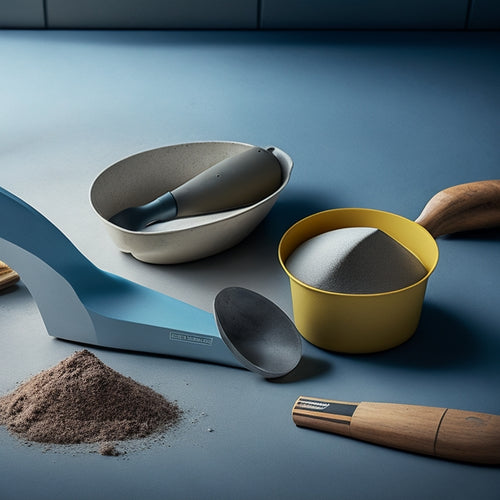
Must-Have Tools for Constructing Concrete Walls
Share
When constructing concrete walls, you'll need a range of essential tools to guarantee accuracy, safety, and quality. For excavation and grading, backhoes, excavators, and skid-steer loaders are must-haves, along with graders, scrapers, and compactors for a smooth surface. Block laying and alignment require level and plumb tools, straightedges, and strings, while concrete mixing and pouring demand mixing drums, pumps, and conveying systems. Don't forget compaction and finishing tools like vibrators, tamping tools, and floats, as well as safety gear and measuring tools. With these tools, you'll be well on your way to building strong, durable concrete walls - and there's more to discover to take your project to the next level.
Key Takeaways
• Excavation and grading tools, such as backhoes and compactors, are essential for site preparation and achieving a stable surface.
• Level and plumb tools, including laser levels and plumb bobs, ensure accurate block laying and structural integrity.
• Concrete mixing and pouring tools, such as mixing drums and concrete pumps, are critical for efficient and quality concrete operations.
• Compaction and finishing tools, including vibrators and tamping tools, are necessary for achieving a smooth, dense, and high-quality finish.
• Safety and protection equipment, such as hard hats and safety goggles, are must-haves for protecting workers from hazards during concrete wall construction.
Essential Excavation and Grading Tools
When building concrete walls, you'll need to clear and prepare the site, which requires a set of essential excavation and grading tools to remove dirt, rocks, and other debris and create a level surface.
You'll need to employ efficient excavation techniques to dig into the earth and remove unwanted materials. This is where backhoes, excavators, and skid-steer loaders come into play. These machines will help you break up compacted soil, remove tree roots, and haul away debris.
Next, you'll need to grade the site to guarantee it's even and compact. Grading equipment such as graders, scrapers, and compactors will help you achieve a smooth, stable surface. These tools will allow you to spread and level soil, remove imperfections, and create a solid foundation for your concrete wall.
Block Laying and Alignment Tools
When building concrete walls, you'll need to make certain that your blocks are laid perfectly straight and level.
To achieve this, you'll rely on block laying and alignment tools that provide accurate references and precise control.
You'll want to have level and plumb tools, as well as straightedges and strings, within easy reach to assure a job well done.
Level and Plumb Tools
You'll rely on level and plumb tools to guarantee accurate block laying and alignment, as even the slightest deviation can compromise the structural integrity of your concrete wall.
A plumb bob is a must-have for ensuring your blocks are perfectly vertical. This simple yet effective tool consists of a weighted string that, when suspended, indicates true verticality.
For more complex layouts, a laser level is essential. This high-tech tool projects a level line or dot, enabling you to accurately align your blocks over long distances. With a laser level, you can quickly and easily check the levelness of your walls, ensuring they're straight and true.
When working with concrete, precision is key, and these level and plumb tools will give you the confidence to build walls that are strong, durable, and aesthetically pleasing.
Straightedge and Strings
To maintain precise block alignment and guarantee accurate spacing, employ a straightedge and strings, a fundamental tool combination that helps you establish a reference line for block laying and verify the position of subsequent blocks.
This duo assures you're working with a straight and level surface, which is vital for a sturdy concrete wall.
When setting up your straightedge and strings, make certain to achieve ideal string tension. This will prevent sagging or bowing, allowing you to maintain straightedge accuracy.
As you lay each block, use the strings as a guide to assure they're aligned correctly. This precision will save you time and effort in the long run, as it eliminates the need for costly corrections.
Concrete Mixing and Pouring Tools
When you're working with concrete walls, you know that getting the mix just right is essential.
You'll need to choose a mixing drum with the right capacity for your project, ensuring you can produce the required volume of concrete without sacrificing quality.
As you prepare to pour, you'll also want to have the right tools on hand to achieve a smooth, even finish.
Mixing Drum Capacity
A mixing drum's capacity is a critical factor in determining the efficiency and feasibility of your concrete mixing and pouring operations. When selecting a mixing drum, you'll need to evaluate the volume of concrete you need to mix and pour in a single batch. A drum that's too small will require multiple batches, increasing labor costs and downtime. On the other hand, a drum that's too large can lead to wasted materials and reduced quality.
You'll also need to assess the mixing techniques you'll be using. Different techniques, such as spiral or planetary mixing, require different drum capacities and materials. Drum materials, such as steel or polyethylene, also affect the drum's capacity and durability. For example, a steel drum may be more durable but heavier, while a polyethylene drum may be lighter but less durable.
When choosing a mixing drum, reflect on your specific needs and operations. Calculate the volume of concrete you need to mix and pour, and select a drum that can handle that capacity efficiently. With the right mixing drum, you'll be able to optimize your concrete mixing and pouring operations, saving time and resources.
Pouring Concrete Smoothly
You'll need a set of specialized tools to pour concrete smoothly, guaranteeing a professional finish and minimizing defects. A concrete pump or a conveying system is essential for efficient and controlled concrete flow. This allows you to pour concrete quickly and evenly, reducing the risk of segregation and honeycombing.
To achieve a smooth finish, you'll also need a set of finishing tools, including a screed board, tamping tool, and float. These tools help to compact and smooth the concrete, eliminating air pockets and imperfections.
Before pouring, it's vital to prepare the surface properly. This involves cleaning the substrate, applying a bonding agent, and laying a layer of sand or aggregate. This surface preparation method guarantees a strong bond between the old and new concrete, preventing delamination and cracking.
Compaction and Finishing Tools
By the time you've poured the concrete, it's essential to have the right compaction and finishing tools on hand to guarantee a smooth, even surface. This stage is critical in achieving the desired finish and maintaining the structural integrity of your concrete wall.
To get it right, you'll need the following essential tools:
-
Vibrators: These tools use vibration techniques to remove air pockets and excess water from the concrete, resulting in a dense and strong finish.
-
Tamping tools: Used to compact the concrete, tamping tools help to eliminate air pockets and guarantee a smooth surface.
-
Floats: These tools are used to apply surface treatments, such as a smooth finish or texture, to the concrete.
- Edgers: Edgers are used to create a clean, defined edge along the perimeter of the wall, giving it a professional finish.
With these compaction and finishing tools in your arsenal, you'll be able to achieve a high-quality finish that meets your project's requirements.
Safety and Protection Equipment
Concrete wall construction poses inherent hazards, and wearing proper safety and protection equipment is essential to preventing injuries and guaranteeing a successful project. You can't afford to take risks when working with heavy concrete, loud machinery, and hazardous materials. Investing in quality safety gear is a must.
Here are the essential safety and protection equipment you'll need:
| Equipment | Purpose |
|---|---|
| Safety Goggles, Hard Hats | Protect eyes and head from debris and falling objects |
| Protective Gloves, Knee Pads | Prevent hand and knee injuries from rough handling and kneeling |
| Ear Protection, Dust Masks | Safeguard against loud noises and airborne contaminants |
| Safety Harnesses, Fall Protection | Prevent falls from heights and guarantee secure anchoring |
Measuring and Leveling Tools
With safety and protection equipment in place, you can now focus on guaranteeing your concrete wall construction project meets precise specifications, which requires accurate measurements and leveling. To achieve this, you'll need the right measuring and leveling tools.
Here are some essential tools to have in your arsenal:
-
Laser Distance Meter: This tool allows you to measure distances quickly and accurately, eliminating the need for manual calculations.
-
Digital Levels: These high-precision tools guarantee your walls are perfectly level and plumb, ensuring a stable structure.
-
Measuring Tapes: Durable and reliable, measuring tapes provide quick measurements for smaller tasks and are ideal for tight spaces.
- Optical Levels: These tools use a lens and prism system to provide precise leveling and alignment, making them perfect for larger projects.
Cleaning and Finishing Accessories
You'll need a range of cleaning and finishing accessories to remove dirt, oil, and other substances that can compromise the bond between the concrete and subsequent coatings or finishes. These accessories are vital in ensuring a strong, durable, and long-lasting concrete wall.
For effective cleaning, you'll require a pressure washer, scrub brushes, and cleaning solutions specifically designed for concrete. These tools will help you employ advanced cleaning techniques to remove stubborn stains and substances.
When it comes to finishing, you'll need a variety of finishing products to achieve the desired texture and appearance. These may include trowels, floats, and edgers, which will help you achieve a smooth, even finish.
Additionally, you may require specialized tools, such as a concrete sealer or a concrete stain, to enhance the appearance and durability of your concrete wall. By investing in these essential cleaning and finishing accessories, you'll be able to achieve a professional-grade finish that meets your project's requirements.
Frequently Asked Questions
How Do I Prevent Water Seepage Through the Concrete Wall?
When building a concrete wall, you'll want to guarantee it's impermeable to water.
To prevent seepage, you'll need to employ effective waterproofing techniques. Apply a waterproofing membrane to the wall's surface, and consider using a drainage system behind the wall to direct water away.
Additionally, guarantee proper drainage solutions, such as weep holes or drainage mats, are integrated into your design.
What Is the Ideal Concrete Mix Ratio for Wall Construction?
When you're building a fortress, you don't want it to crumble, do you?
The ideal concrete mix ratio for wall construction is essential to achieving the desired wall strength.
Aim for a mix of 1 part cement, 2 parts sand, and 3 parts aggregate (by volume).
This ratio will give you a robust concrete mix with a compressive strength of around 3000-4000 psi, perfect for withstanding the test of time and the elements.
Can I Use a Laser Level for Wall Alignment?
You're wondering if a laser level can aid in wall alignment. Absolutely!
A laser level offers numerous benefits, including enhanced accuracy and speed. When used correctly, it guarantees precise wall alignment, saving you time and resources.
How Often Should I Clean My Concrete Finishing Tools?
You know that timely tool maintenance is essential for peak performance.
When it comes to cleaning your concrete finishing tools, you should do it frequently to prevent cement buildup. Aim to clean them after every use, or at least daily, depending on the tool's usage.
Regular cleaning guarantees your tools remain in top condition, allowing you to achieve professional-grade results.
Are Concrete Wall Anchors Necessary for All Wall Types?
Are you building a wall that'll stand the test of time? You're probably wondering if concrete wall anchors are necessary for all wall types.
The answer is, it depends on the load-bearing capacity and structural integrity you need. If you're dealing with heavy loads or unstable soil, yes, concrete wall anchors are a must.
Proper anchor installation guarantees a secure hold, preventing cracks and collapses. Don't risk it – use anchors where necessary to assure a rock-solid structure.
Conclusion
As you stand back to admire your newly constructed concrete wall, you can take pride in knowing that it was built on a foundation of precision and quality, thanks to the must-have tools that helped you get the job done right.
From excavation to finishing touches, each tool played its part in harmony, like a symphony of steel and concrete, to create a structure that's strong, durable, and a reflection of your craftsmanship.
Related Posts
-

Must-Have Tools for Laying Concrete Tiles
When laying concrete tiles, you'll need a range of essential tools to get the job done right. Start with subfloor pre...
-

Top Concrete Resurfacing Tools for a Pro Finish
When it comes to achieving a professional finish in concrete resurfacing projects, you require the right set of speci...
-

Ergonomic Concrete Tools for Tight Spaces
When you're tackling concrete work in tight spaces, ergonomic tools are your best bet for comfort and efficiency. The...


